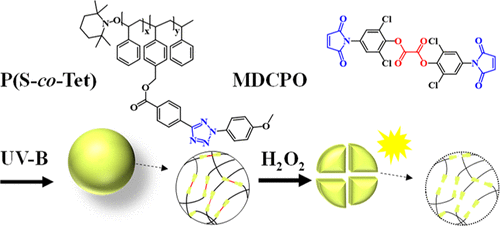当前位置:
X-MOL 学术
›
Macromolecules
›
论文详情
Our official English website, www.x-mol.net, welcomes your feedback! (Note: you will need to create a separate account there.)
Chemiluminescent Read-Out of Degradable Fluorescent Polymer Particles
Macromolecules ( IF 5.5 ) Pub Date : 2020-07-06 , DOI: 10.1021/acs.macromol.0c00722 Laura Delafresnaye 1 , Jordan P. Hooker 1 , Christian W. Schmitt 1 , Leonie Barner 2 , Christopher Barner-Kowollik 1
Macromolecules ( IF 5.5 ) Pub Date : 2020-07-06 , DOI: 10.1021/acs.macromol.0c00722 Laura Delafresnaye 1 , Jordan P. Hooker 1 , Christian W. Schmitt 1 , Leonie Barner 2 , Christopher Barner-Kowollik 1
Affiliation

|
The design of chemiluminescent degradable particles is largely an unexplored field. We, herein, pioneer self-reporting chemiluminescent microspheres, allowing one to readily monitor their degradation. Initially, fluorescent particle formation is induced by cross-linking a photoreactive polymer (poly(styrene-co-tetrazole), 1900 g mol–1, Đ = 1.1) and a peroxyoxalate dilinker under irradiation (λmax = 300 nm) employing the nitrile–imine tetrazole-ene cycloaddition (NITEC). Similar to a precipitation polymerization technique, the synthesis does not require any stabilizers, bases, or initiators and proceeds at ambient temperature to yield highly fluorescent microspheres (Dn = 700 nm) in less than 30 min. Next, the particles are degraded on demand by addition of hydrogen peroxide that cleaves the peroxyoxalate linking points and subsequently disintegrates the particles. Degradation of the microspheres can be readily monitored by the light emitted during the peroxyoxalate chemiluminescent reaction process. Importantly, while the present contribution describes the incorporation of degradable CL linkages into polymeric microspheres, the approach can be more broadly implemented in the synthesis of complex macromolecular architectures facilitating optical readout of degradable scaffolds.
中文翻译:

可降解荧光聚合物颗粒的化学发光读数
化学发光可降解颗粒的设计很大程度上是一个尚未探索的领域。我们在此开创了自报告化学发光微球的先驱,使人们能够轻松地监测其降解。最初,通过使用腈将光反应性聚合物(聚(苯乙烯-共-四唑),1900 g mol –1,Đ = 1.1)和过氧草酸酯双键交联剂在交联下(λmax = 300 nm)交联,诱导形成荧光颗粒。-亚胺四唑-烯环加成(NITEC)。类似于沉淀聚合技术,合成过程不需要任何稳定剂,碱或引发剂,并且可以在环境温度下进行以生成高度荧光的微球(D n= 700 nm)在不到30分钟的时间内。接下来,通过添加过氧化氢将颗粒按需降解,所述过氧化氢裂解过氧草酸酯的连接点并随后使颗粒崩解。微球的降解可以通过过氧草酸酯化学发光反应过程中发出的光来容易地监测。重要的是,尽管本发明描述了将可降解的CL键结合到聚合物微球中,但是该方法可以在合成大分子结构的合成中更广泛地实施,以促进可降解支架的光学读出。
更新日期:2020-07-28
中文翻译:

可降解荧光聚合物颗粒的化学发光读数
化学发光可降解颗粒的设计很大程度上是一个尚未探索的领域。我们在此开创了自报告化学发光微球的先驱,使人们能够轻松地监测其降解。最初,通过使用腈将光反应性聚合物(聚(苯乙烯-共-四唑),1900 g mol –1,Đ = 1.1)和过氧草酸酯双键交联剂在交联下(λmax = 300 nm)交联,诱导形成荧光颗粒。-亚胺四唑-烯环加成(NITEC)。类似于沉淀聚合技术,合成过程不需要任何稳定剂,碱或引发剂,并且可以在环境温度下进行以生成高度荧光的微球(D n= 700 nm)在不到30分钟的时间内。接下来,通过添加过氧化氢将颗粒按需降解,所述过氧化氢裂解过氧草酸酯的连接点并随后使颗粒崩解。微球的降解可以通过过氧草酸酯化学发光反应过程中发出的光来容易地监测。重要的是,尽管本发明描述了将可降解的CL键结合到聚合物微球中,但是该方法可以在合成大分子结构的合成中更广泛地实施,以促进可降解支架的光学读出。



























 京公网安备 11010802027423号
京公网安备 11010802027423号